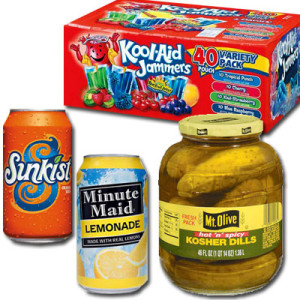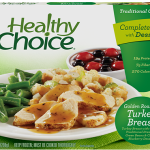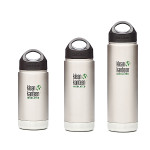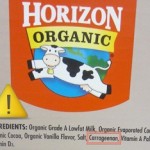Here is a summary of this blog post featured on Info Wars Nightly News: Sodium Benzoate
I have a challenge for all of you today! That challenge is to rid your pantry and refrigerator of Sodium Benzoate. This chemical preservative is used to help inhibit the growth of bacteria and fungus in acidic products. It’s the cheapest mold inhibiter on the market, which is why it is so often used. Acidic foods tend to grow bacteria, mold and yeast more easily than non-acidic foods, so the Sodium Benzoate extends the shelf life. It is widely used in foods, beverages, cosmetics, dental care products, and pharmaceuticals. I even found it in Hyland’s Homeopathic Cough syrup. It is also found in a lot of food in restaurants. For example, Subway’s jalapeños, pickles, banana peppers and teriyaki glaze use Sodium Benzoate as a preservative.
Sodium benzoate is considerably more toxic than either processed sugar or high fructose corn syrup. It may exacerbate asthma, hyperactive behavior (when consumed in products with certain food colorings), and cause skin rash upon contact. A study in 2007 indicated that it may cause serious cell damage associated with cirrhosis of the liver, aging, and Parkinson’s disease. In animal studies, there are reports of possible weight gain, liver and kidney issues, and birth defects. (Source)
This ingredient has been linked with creating free radicals in the body, destorying mitochondrial DNA, and thus adding to the body’s aging process. Readily absorbed by the skin, Sodium Benzoate’s presence in anti-aging products may, ironically, actually age you faster, by damaging your DNA.
Sodium benzoate has been linked to cancer, but is not known to be carcinogenic on its own. There have been concerns by the FDA that when both vitamin C (ascorbic acid) and sodium benzoate are mixed, they form benzene, a known human carcinogen and DNA damager. This creates a serious concern, because sodium benzoate is commonly used in acidic foods with vitamin C, such as juices, sodas and salad dressings. The FDA says it’s safe because the amount used to preserve foods is very low, but don’t ever combine it with vitamin C, as this causes benzene to be formed.
Outside of our foods, benzene is the main ingredient in various paint stripper products, rubber cements, and spot removers, due it its highly destructive and solvent qualities. It was discontinued in rubber manufacture in the U.S. because it caused large percentages of workers to get leukemia. (Source)
When reading your labels to confirm if Vitamin C is in the product, look for any of these names: Ascorbic Acid, Acide Ascorbique, Acide Cévitamique, Acide Iso-Ascorbique, Acide L-Ascorbique, Acido Ascorbico, Antiscorbutic Vitamin, Ascorbate, Ascorbate de Calcium, Ascorbate de Sodium, Ascorbyl Palmitate, Calcium Ascorbate, Cevitamic Acid, Iso-Ascorbic Acid, L-Ascorbic Acid, Magnesium Ascorbate, Palmitate d’Ascorbyl, Selenium Ascorbate, Sodium Ascorbate, Vitamina C, Vitamine Antiscorbutique, Vitamine C.
Cancer is all about the cumulative effect. When the human body is exposed repeatedly to any level of this carcinogen, which is found in thousands of products, the immune system, over time, is depleted to the point that one acquires an immune deficiency. Then the body does not have enough essential nutrients to detoxify, and this occurs at the cellular level. Parkinson’s, neuro-degenerative diseases, and premature aging have all been attributed to this infamous preservative. – Natural News
When going through your pantry look closely at the labels for:
- Vinegar (salad dressings, pickled foods)
- Carbonic acid (carbonated drinks)
- Citric acid (jams, fruit juices, cough syrups, baby wipes, liquid hand soaps)
- Alcohol (alcohol-based mouthwash)
- Other high acids (soy sauce, Chinese food sauces)
We found replacements for many of the products in our pantry/refrigerator that contained Sodium Benzoate. Read about them here.
~ “When you know better, you do better.” – Maya Angelou





Be aware that you might see this show up in your food as potassium benzoate. Since it’s got the benzoate ion in it, I’m betting it’s just as bad.
Hi John,
Yep, potassium benzoate is not good! http://www.examiner.com/article/potassium-benzoate-hazards
Best,
Julie
[ Smiles ] Thank you for doing your part in educating the public about the dangers of sodium benzoate.
Great article!
Thank you for the kind words, Renard!
What can you eat?! Unless you make it or manufacture it yourself — it’s all bad! Are worms good because I’m about ready to eat some. Seriously, I’ve known about some foods and drinks being bad but this is going over the top anymore. And we are paying way more. Never thought I would see this in America since we were the “bread basket” of the world — at one time. Now it is being poisoned or going overseas. Can’t we just turn this around? Somehow? I hate growing and making EVERYTHING! I know — spoiled rotten — spoiled rotten.
Hi Jan!
It is so frustrating, I know! We had a really hard time when we started removing processed foods from our house, but it does get easier, which is one reason I started this blog. I truly believe in the power of whole foods — the energy level transformation and mental clarity are unbelievable. Once you adopt this new lifestyle, a lot of things you had to think hard about in the beginning, become second nature. You will have more meal & snack ideas to pull from. As with most things, the more you do it, the better you get at it and the easier it becomes.
Thank you for your note!
Julie
P.S. I don’t know if worms are good for you, but I wouldn’t eat them either way :).
An interesting dialogue is worth comment. I feel that you must write more on this topic, it won’t be a taboo subject but typically people are not sufficient to speak on such topics. To the next. Cheers kfbekgbcagba
The trouble is…. you all want completely preservative-free food. It’s not gonna happen. Potassium sorbate/sodium benzoate in combination with a bit of citric acid is one of the lowest possible toxicity solutions available to food producers. Yes, benzoate with ascorbic acid may form benzene, however most pop manufacturers have reduced levels of benzoate or replaced the ascorbic with other acids so that this isn’t an issue anymore. Reading MSDS sheets on ingredients can be daunting and unless you have a degree in chemistry you’re not qualified to comment. Typically ingredients are blended into other products, their use levels are a few percent or less. This changes how the ingredient works and how it reacts with other ingredients in the product. Lets take a look at water, technically at 100% concentration on your skin for more than a day it too is hazardous. You can’t scare-monger every single ingredient based on MSDS and limited knowledge. On the cosmetics side we are now down to perhaps only a couple of preservatives due to the paraben scare (I don’t like parabens either haven’t used them in 20yrs), however many good preservatives have been scare-mongered out of use. Formulators now have an extremely difficult time finding non-toxic preservatives that work (broad spectrum) on all combinations of ingredients… a tall order. Nobody wants a cosmetic with mold/bacteria/rancidity right?? Sure, go ahead and make your own stuff but 95% of people don’t have the time/space/knowledge to do it and that homemade product of yours won’t last more than a week in the fridge. If you make your friend sick that’s not so bad but as a manufacturer making a lot of customers sick is game over. It’s up to you but as a formulator I have to say it’s more and more frustrating dealing with misinformation on a daily basis.
all part to reduce global population. by the Illuminati.
I have to stay away from Benzoates and can’t really confirm if lettuce and apples are good or bad for me.
Pingback: La Lista de Super que todo el Mundo debe conocer | CONSPIRACION
Pingback: Chocolate Muffins | Ravenclaw